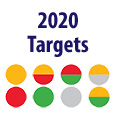Achieve gender equality and empower all women and girls

International commitments to advance gender equality have brought about improvements in some areas: child marriage and female genital mutilation (FGM) have declined in recent years, and women’s representation in the political arena is higher than ever before. But the promise of a world in which every woman and girl enjoys full gender equality, and where all legal, social and economic barriers to their empowerment have been removed, remains unfulfilled. In fact, that goal is probably even more distant than before, since women and girls are being hit hard by the COVID-19 pandemic. The crisis is creating circumstances that have already contributed to a surge in reports of violence against women and girls, and may increase child marriage and FGM. Moreover, women are likely to take on most additional care work owing to the closure of schools and day-care centres. They are also on the front lines in fighting the coronavirus, since women account for nearly 70 per cent of health and social workers globally.
COVID-19 is intensifying the risk of violence against women and girls
The coronavirus pandemic lockdowns have confined many women and girls to their homes, sometimes with abusive partners, putting them at greater risk of domestic violence. Even before the pandemic, physical and sexual violence against women were all too common. According to surveys conducted between 2005 and 2017 in 106 countries, 18 per cent of ever-partnered women and girls 15 to 49 years of age experienced such violence by a current or former intimate partner in the 12 months prior to the survey.
Already, data from several countries show an increase in reporting of domestic violence to helplines, women’s refuges and shelters, and the police. When considering such data, it is important to keep in mind that less than 40 per cent of women who experience violence report this crime or seek help. Being confined at home with an abusive partner and, in some countries, lacking access to mobile phones or the Internet, makes it more difficult for women to safely reach out for help. According to data from 66 countries over the period 2016 to 2018, mobile phone ownership among women was 6.8 percentage points lower than for men, on average. Women are also more likely to have their phones monitored by abusive or controlling partners. In addition, because of service disruptions and closures, women experiencing violence have less access to support and may not seek or be able to receive medical care, if needed.
The global pandemic could set back progress to end child marriage and female genital mutilation
Marriage before the age of 18 is a human rights violation, mostly affecting girls, and can lead to a lifetime of disadvantage and deprivation. One in five women (20.2 per cent) between the ages of 20 and 24 was married before the age of 18 around 2019, compared with about one in four (23.8 per cent) 10 years earlier. Southern Asia has seen the greatest decline over this period. Today, the risk of child marriage is highest in sub-Saharan Africa, where more than one in three women (34.5 per cent) between the ages of 20 and 24 were married before the age of 18. School closures and widening poverty as a result of the pandemic could put more girls at risk.
FGM is another blatant violation of human rights. At least 200 million girls and women have been subjected to FGM in 31 countries where the practice is concentrated; half of these countries are in Western Africa. Although this harmful practice has been declining, there are still countries where FGM is almost universal – where at least 9 in 10 girls and women aged 15 to 49 years have been cut. Even in countries where the practice has become less common, progress would need to accelerate by a factor of 10 to meet the global target of elimination by 2030, owing to population growth. COVID-19 is interrupting programmes to end FGM, which could threaten progress.
Proportion of women 20 to 24 years of age who were married or in union before age 15 and before age 18, around 2009 and around 2019 (percentage)
* Excluding Australia and New Zealand
Note: The values for 2019 refer to the latest available data for 91 countries (covering 77 per cent of the world's population of women aged 20 to 24 years) over the period 2013–2019. The values for 2009 refer to the latest available data for these countries over the period 2003–2009. Confidence intervals are not shown here, and apparent differences over time may not be statistically significant.
Women spend more time than men in unpaid work, a burden that is likely to get heavier during the pandemic
In an average day, women spend about three times as many hours in unpaid domestic and care work as men, according to the latest data from 89 countries and areas between 2001 and 2018. Time spent in these activities tends to be even higher for women with young children at home. In roughly 75 per cent of countries with trend data, a small decrease has been observed in the time spent by women on unpaid domestic and care work compared with that spent by men.
The COVID-19 crisis is radically changing how people, particularly women, spend their time – often with a negative impact on their well-being. A poll conducted in 17 countries shows that both women and men are taking more responsibility for household chores and the care of children and family during the lockdown, but the majority of work continues to fall on women and girls, reflecting a pre-pandemic pattern.
Proportion of time spent on unpaid domestic and care work, women and men, 2001–2018 (latest available) (percentage of time spent per day)
Note: The figure reflects available data for 89 countries and areas over the period 2001–2018. The number of countries and areas represented in each type of unpaid work is indicated in parentheses.
Women are increasingly assuming positions of power, but the world is still far from parity
As of 1 January 2020, women’s representation in national parliaments (lower chamber and unicameral parliaments) had reached 24.9 per cent – up from 22.3 per cent in 2015. The share of female representation ranged from more than 30 per cent in Australia and New Zealand, Latin America and the Caribbean, and Europe to only 6.2 per cent in Oceania (excluding Australia and New Zealand). Data from 133 countries and areas show that women now have better access to decision-making positions at the local level, holding 36.3 per cent of elected seats in local deliberative bodies. Only 13 per cent and 15 per cent of countries, respectively, have reached gender balance (40 per cent or more) in legislative bodies in national parliaments and in local government. This progress is largely attributed to legislated gender quotas.
In 2019, women represented 39 per cent of the world’s workers and half of the world’s working-age population, but only 28 per cent of managerial positions (up from 25 per cent in 2000). Women face higher barriers than men in accessing employment. And when they do get a job, they are often excluded from decision-making positions. In 2019, women accounted for 41 per cent of managerial positions in South-Eastern Asia and 40 per cent in Northern America, but only 8 per cent in Northern Africa.
In the context of COVID-19, it is critical that women are fairly represented in leadership positions related to the pandemic. This will help to avoid deepening existing inequalities. It will also ensure that gender dimensions and investments in gender equality are included in response and recovery legislation, economic packages and budgets during and after the pandemic.
Women's lack of decision-making power extends even to their own reproductive health
Slightly more than half of all women (55 per cent) make their own decisions when it comes to sexual and reproductive health and rights, based on 2007–2018 data from 57 countries on women aged 15 to 49 who are either married or in union. The analysis also found that women have the most autonomy in deciding on the use of contraception (91 per cent). However, only three in four women are making their own decisions regarding health care or on whether or not to have sex.
Progress on other fronts is encouraging: in 2019, countries had established 73 per cent of the laws and regulations needed to guarantee full and equal access to sexual and reproductive health and rights, according to data from 75 countries. The findings were particularly heartening when it comes to HIV. On average, countries had set in place 87 per cent of laws and regulations needed for HIV counselling and testing services; 91 per cent of those needed for HIV treatment and care services; and 96 per cent for HIV confidentiality. Meanwhile, countries had instituted 79 per cent of relevant laws and regulations that stipulate full, free and informed consent of individuals before they receive contraceptive services, including sterilization.

